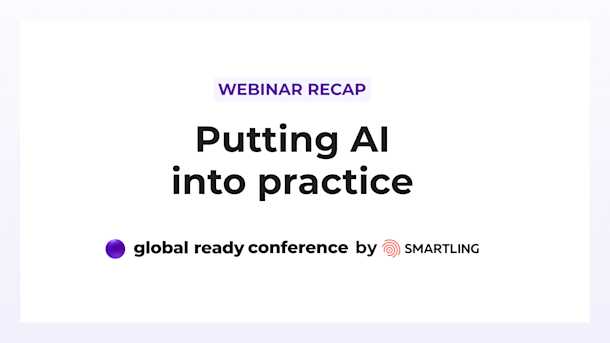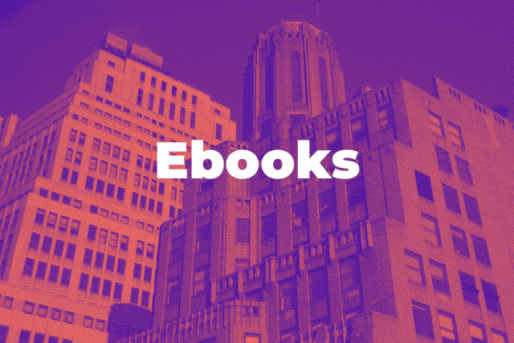There’s been an increased appetite within the translation industry for AI-powered solutions. However, while companies are anxious to experiment with this new technology, there are also many questions about how to put AI translation into practice effectively. If you’re looking for tips and best practices, these webinars from Smartling’s 2024 Global Ready Conference are a good place to start.
First, hear from Liliana Pardo-Becerra, a senior manager of localization at Vimeo, and Juan Muñiz, a senior manager of localization at Bluebeam, about how they are experimenting with AI to do more with less. They discuss their current practices and what’s on their AI-powered translation roadmap.
Then, join Smartling’s panel of in-house localization experts — featuring Andrew Batwash (Director of Language Services), Valerie Dehant (Senior Director of Language Services), and Olga Beregovaya (Vice President of AI) — as they discuss how to scale your quality assurance program and measure quality in an AI-driven world.
Bridging the Gap: A Time of Exploration and Discovery
Bluebeam develops technology solutions for the architecture, engineering, and construction industry. Its localization team is four people strong, and the company’s products are currently available in 14 languages.
Vimeo offers people around the world a platform to create, edit, and share videos. Its two-person localization team is responsible for translating the video software company’s content into seven languages and is looking to expand into more languages in the future.
In describing their forays into AI translation, Liliana Pardo-Becerra (from Vimeo) and Juan Muñiz (from Bluebeam) mentioned they’ve taken a cautious approach. They want to take advantage of the new technologies, but maintaining quality standards is paramount.
Dipping Their Toes In
Both companies’ localization teams began experimenting with AI within the last year or so. They wanted to see how they could leverage the AI-powered advancements alongside machine translation (MT) to do more with less.
For Bluebeam, their experiments have centered around using an MT plus human post-editing workflow for their technical support material. Results so far have been promising: they’ve been happy with the quality and have been able to cut their turnaround time from an average of nine days to five.
Vimeo invested in custom engine training for MT at the beginning of this year. Like Bluebeam, Vimeo started experimenting first with their support content, and the localization team has been very pleased with the output.
Still, Liliana Pardo-Becerra and Juan Muñiz both emphasized the importance of keeping human localization experts in the loop. AI translation technologies may be powerful, but they can still introduce errors. To mitigate the risks of using AI, Bluebeam and Vimeo still use humans to review and validate the translated output.
Looking Ahead
Next up for the localization teams is exploring what other content types might benefit from AI-powered translation. For example, they both plan to experiment with putting lower-visibility marketing content through an MT workflow.
In addition, Vimeo expressed interest in exploring how AI can help them translate certain visual assets and video content. What would be very time-consuming, resource-heavy, and costly to translate using traditional tools and workflows may now be more feasible with AI — especially in light of the time and cost savings they’re already seeing from embracing this new technology.
Finally, Bluebeam and Vimeo are excited to understand how else AI can help them and their colleagues do their jobs more efficiently outside of the translation workflow. From using AI to create or internationalize source content to preparing files for translation and otherwise lightening their administrative workloads, possibilities abound.
Scaling Up While Ensuring Translation Quality
AI-powered solutions are helping Vimeo, Bluebeam, and others to scale their translation efforts. However, generating more and more multilingual content brings its own challenges, including how to ensure quality management programs keep pace. Smartling experts Andrew Batwash, Valerie Dehant, and Olga Beregovaya discuss how to scale while ensuring translation quality in this AI world. Here are just a few of their insights.
Quality Will Become the Top Priority
As we rely more heavily on AI-based solutions, Smartling expects both the cost of translation and translation turnaround times to decrease. As a result, quality will become the key metric when measuring translation ROI as it relates to business goals, and attaining the right quality level for certain types of content will become very important.
The question that businesses and their language service providers will need to answer will be as follows: How can we deploy quality management processes at the right place for the right content to get it to the right quality level for a specific audience and market?
In With the New Error Typologies
AI-powered translation solutions such as MT and large language models (LLMs) are showing a lot of promise. Many businesses are excited about leveraging AI in different places in the localization workflow: indeed, there are myriad possibilities, from automation to translation to localized content creation.
But, while these tools are impressive and can produce high-quality outputs, it is important to keep in mind their current limitations. For example, as with any translation solution, there is a risk that errors can slip through and appear in the localized content. Those errors, however, are not necessarily the same style and terminology errors that localization professionals are used to looking for and correcting. Andrew Batwash and Olga Beregovaya mention several new error typologies to watch out for: hallucinations, toxicity in MT, culturally appropriate translations, copyright liability, the inherent biases of AI output, and more.
The current translation quality framework must evolve to manage quality in light of these new error typologies. In addition, companies will need to put agile quality management processes in place to ensure they can identify and address these types of errors.
Here is where a tech-first translation company like Smartling can help: Quality tools are built into Smartling’s translation management system. These tools are able to apply industry-recognized evaluation frameworks, which are very customizable and will be able to evolve with the new technology. Smartling can also help you set up your quality management program so that you are in the best possible position to maximize your gains from these exciting technologies while minimizing the risks.
The Role of the Translator
While it may seem like machines are taking over, human translators still have an important role to play. Indeed, translators are more important than ever.
Valerie Dehant elaborates on this point, “The highly skilled linguists are more important because they’re really feeding back into and training the machine and the AI models. Every input they bring in is going to help with those biases we see in translation from the models.”
She then describes how Smartling views the role of the linguist — both translators and quality evaluators — in this new AI world: the linguist will become more like a copilot to the AI models. While the possibilities for AI are infinite, it’s clear that humans will be needed to ensure that model training data is of top-notch quality and to review, fact-check, and evaluate certain types of translated content. Not only that, but other content types, such as those that involve quite a bit of creative thinking to localize (e.g., high-profile marketing content), will still require a human touch for many years to come.
—
Want to learn more about putting AI into practice? Watch this year’s Global Ready Conference in its entirety. All sessions are available on demand here.





.jpg)
